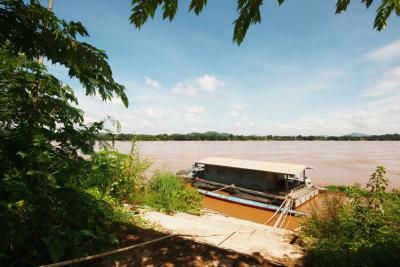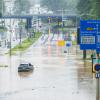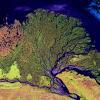Introduction
The floating solution offers several opportunities for environmental sustainability. These opportunities are important to integrate in the concept of floating architecture. Floating solutions have an important potential to address climate change challenges in the built environment. These affect a large population affected by flooding and sea level rise. For example, the C40 network estimates that 800 million people will be put at risk from sea level rise of at least half a meter by the 2050s. Global average sea level has already risen by about 16–21 cm since 1900, with about 7 cm occurring since 1993 (CSSR).
This article lists the most important benefits and impacts of floating development and mentions some of the available references.
Environmental benefits of floating development
River connectivity
Floating development can provide more connectivity to water bodies than for example converting these bodies to land.
 Source: Murray Darling Basin Authority. River Flows and Connectivity.
Source: Murray Darling Basin Authority. River Flows and Connectivity.
Providing habitat
Research studies addressing the impact of floating structures are scarce. Floating development can stimulate diversity in water environments and provides a protected habitats for small fish and other aquatic animals for example through providing a substrate and protection from wave action (Lima et al 2022).
Less pressure on sand mining
Floating development poses less pressure on sand mining, which is a very destructive practice for the worlds rivers. Up to 50 billion tonnes of sand and gravel are mined each year to meet soaring demand from construction and land reclamation – making it the largest extractive industry on the planet. The problem is that these benefits of the natural sediment flow in rivers are usually ‘hidden’ from decision-makers. Coupled with poor governance and a lack of enforcement of regulations in many countries, this blinkered approach to the impacts of sand mining leave many rivers at the mercy of sand miners.(WWF web article and publication).
Sand mining is becoming a serious issue globally. For those who are interested in learning more, I'd recommend the following:
- Article: Time is running out for sand- Nature Research
- Video: Illegal Sand Mining Is Ruining These Countries' Ecosystems
- A seminar by We@Sea, organized by Offshore Service Facilities.
- UNEP document: Sand and Sustainability: 10 strategic recommendations to avert a crisis
Energy efficiency
For instance, offshore wind energy, wave energy and photovoltaic cells on the sea can be used to provide new renewable energy source for the future and reduce dependence on other resources (Habibi 2015).
Due to temperature difference between the water and the outdoor air, hydrothermal use of the water can play a significant role in providing energy source which can be used both for cooling and heating (Habibi 2015).
Wave energy or Sea wave energy conversion can provide renewable energy for coastal cities and communities. For example, the design of floating hotel "Salt and Sill in Sweden was done with the environment sustainability concept such as heating energy for the building which is actually generated by geothermal wheels from underneath the building, at the bottom of the sea (Habibi 2015).
Environmental impacts
Water quality
Although the results from several different study locations show lower dissolved oxygen concentrations and higher temperature measured underneath the floating structures, the magnitude of the detected differences suggest that water quality is not critically affected by the presence of the floating houses (Lima et al 2022).
More references on impacts from floating solar will be posted here soon. This was presented during the knowledge exchange on the 29th of Sep 2022.
References
Lima, Rui L. Pedroso de, Rutger E. de Graaf-van Dinther, and Floris C. Boogaard. ‘Impacts of Floating Urbanization on Water Quality and Aquatic Ecosystems: A Study Based on in Situ Data and Observations’. Journal of Water and Climate Change, 16 February 2022, jwc2022325. https://doi.org/10.2166/wcc.2022.325.
Habibi S (2015) Floating Building Opportunities for Future Sustainable Development and Energy Efficiency Gains. J Archit Eng Tech 4:142. doi:10.4172/2168-9717.1000142
Jacqueline E. Tamis*, Ruud H. Jongbloed, Gerjan J. Piet, Robbert G. Jak. 2021. Developing an Environmental Impact Assessment for Floating Island Applications. https://doi.org/10.3389/fmars.2021.664055
Koehnken - et al 2020. Impacts of Riverine Sand Mining on Freshwater Ecosystems: A Review of the Scientific Evidence and Guidance for Future Research - 2020 - River Research and Applications - Wiley Online Library’. https://onlinelibrary.wiley.com/doi/10.1002/rra.3586.
Further resources
- Study: Floating Building Opportunities for Future Sustainable Development and Energy Efficiency Gains
- Article: Developing an Environmental Impact Assessment for Floating Island Applications
- Article: Impacts of riverine sand mining on freshwater ecosystems: A review of the scientific evidence [...]
- Report: The Floating Greenhouse on the Thames - Guidelines for nature based solution








Trending Discussions
From around the site...
“Absolutely interested! I'll connect via email to discuss reviewing and enhancing the Economic Analysis of Climate...”
Adaptation-related events at COP28 (all available to follow/stream online)
“Please check out these adaptation-related events taking place at COP28 - all available online (some in person too if...”
Shining a light for biodiversity – four perspectives to the life that sustains us. Four hybrid sessions.
“30 November to 19 December 2023 - Four Sessions Introduction The SDC Cluster Green is happy to invite you to the...”